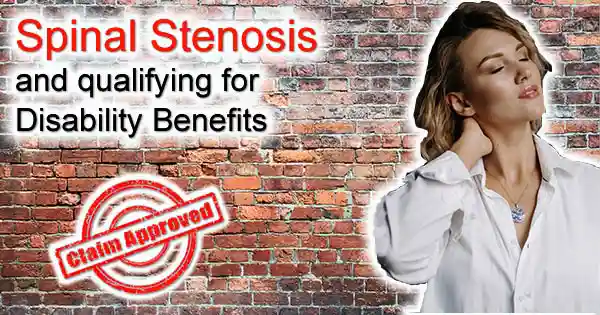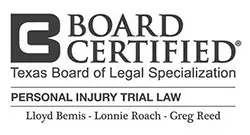Can Spinal Stenosis qualify for SS Disability Benefits?
Can I get disability benefits if I am suffering from the effects of Spinal stenosis?
Author: Attorney Greg Reed
Updated: 1/22/2024
Spinal stenosis is a condition that primarily affects both men and women over the age of 50. The spine is a column of small bones called vertebrae that run from the neck to the lower back, providing support for the upper body. Nerves in the spine travel through the openings in the vertebrae, conducting signals from the brain to the rest of the body. These spinal nerves form the spinal cord. The bones surrounding the spinal cord protect the nerves and if damaged, can affect walking, balance and sensation. If you are suffering from the effects of Spinal stenosis you may qualify for disability benefits.

The SSA has a specific disability listing for lumbar stenosis. If your condition meets the listing criteria, it will automatically be considered a disability. Call 512-454-4000 for help today.
Some people with spinal stenosis have no symptoms, but others experience pain, numbness, tingling and muscle weakness.
In cervical spinal stenosis, the most common symptoms include:
- Weakness in hands, arms, feet or legs;
- Neck pain;
- Difficulty with walking or balance;
- Numbness or tingling in arms, hands, feet or legs;
- Bladder or bowel dysfunction (in severe cases).
In cases of lumbar spinal stenosis, a person may experience the following:
- Pain and/or cramping in one or both legs when walking or standing for long periods of time that eases when sitting or bending forward;
- Numbness and tingling in feet and legs;
- Weakness in feet or legs;
- Back pain.
- Cauda equina syndrome. This is a rare, serious condition that affects a bundle of nerve roots called cauda equina at the base of the spine. Pressure in this area can cause an individual to lose feeling in the pelvic area.
These or a combination of these symptoms can cause you to miss work and jeopardize your ability to maintain employment.
Conditions which may lead to spinal stenosis include:
- Arthritis
- Herniated disks.
- Thickened ligaments. Ligaments that hold the bones of the spine together can become stiff over time and bulge into the spinal canal.
- Bone spurs on the spine.
- Tumors on the spinal cord.
- Rheumatoid arthritis.
- Spinal injuries; for example, from a car accident or other trauma.
- Ankylosing spondylitis – a type of arthritis that leads to bone spurs.
- Achondroplasia – an inherited condition which interferes with bone formation in the spine.
- Congenital spinal stenosis -a birth defect where the spine is naturally narrow.
- Scoliosis.
These conditions and accompanying symptoms can affect your ability to maintain employment.
Treatment typically includes pain medications, cortisone injections into the spine, and physical therapy.
In severe cases, for example, if spinal stenosis affects an individual’s ability to walk, surgery may be recommended.
Following your doctor’s treatment plan is an important part of qualifying for disability benefits.
Qualifying for Disability for Spinal stenosis
Spinal stenosis can easily impact a person’s daily activities and prevent an individual from working.
The SSA does not specifically mention cervical spinal stenosis in its Blue Book, but it does have a listing for lumbar spinal stenosis, Section 1.16. However, qualifying for disability under this impairment is complicated and an applicant should ask their doctor to help them determine if they meet the criteria.
To qualify you must have ALL of the following:
- One sign of neurological compromise in the cauda equina. This can be:
- Nonradicular (non-radiating) distribution of pain in a leg or foot; OR
- Nonradicular distribution of sensory loss in a leg or foot; OR
- Neurogenic claudication (intermittent leg pain).
- A diagnostic test or clinical exam showing nonradicular neurological signs of muscle weakness and sensory changes evidenced by one of the following:
- Decreased sensation; OR
- Sensory nerve deficit on electrodiagnostic testing; OR
- Lack of reflexes, trophic ulceration, bladder or bowel incontinence; OR
- Decreased deep tendon reflexes in one or both lower extremities.
-
An MRI, CT scan or other imaging, or in an operative report showing compromise of the cauda equina with lumbar spinal stenosis. - Physical limitation of musculoskeletal functioning related to lumbar spinal stenosis that has lasted, or is expected to last at least 12 months, and medical documentation of at least one of the following:
- A documented medical need for a walker, bilateral canes or crutches or a wheelchair or scooter that involves the use of both hands; OR
- An inability to use one hand and need to use the other to operate a one-handed wheelchair, cane, crutch, or other device.
AND
AND
AND
You will need to provide detailed medical records to Social Security that include:
- Notes from a detailed medical exam (including testing of reflexes and muscle strength);
- Medications you are taking and side effects;
- Treatments such as physical therapy and steroid injections;
- Results of MRIs and CT scans;
- Doctors’ notes regarding your physical limitations, such as whether you need a cane or how long you are able to stand.

If you are able to walk without assistance, you will not qualify for SSDI automatically.
Instead, Social Security will conduct a Residual Functioning Capacity (RFC) assessment to evaluate how spinal stenosis affects your capacity to perform your job and daily activities. Social Security will review your imaging tests and doctor’s records, particularly their notes on your functional limitations, to decide if your spinal stenosis prevents you from working. Social Security will also consider your age, level of education, and work skills. If you are older than 55 with few transferable work skills and less education, your chances for being approved are greater. If you are suffering from cervical spinal stenosis, Social Security will evaluate your impairment in the same way.
Once Social Security determines the limitations caused by your condition, they will employ a vocational expert to assess whether a person with these limitations is employable.
Most vocational experts will find a person to be unemployable if their condition or the treatment rendered for the condition causes the person to regularly be absent two or more days a month or be “off-task” 15% or more of the workday.
The Social Security Administration revised its Musculoskeletal Disorders listings in April 2021, making it more difficult to qualify for disability benefits with those impairments.
If you have spinal stenosis, you may be eligible for Social Security Disability Income; however, you will need to depend on your medical providers to submit the needed medical evidence of your functional limitations and restrictions. An experienced Social Security Disability attorney can help you by contacting your doctor and gathering all the information you need to ensure a successful claim.
If you are 55 or older or have another medical condition you may get approval.
Social Security follows a set of rules to determine when the agency expects an applicant to learn a new job.
Applicants who are 55 or older often fall under a grid rule, which means they are not expected to learn a new job. For example, a 55-year-old applicant with no transferable skills might be found disabled. If you can’t go back to your old job, and you don’t have the skills to learn a new one, Social Security will likely grant you disability benefits.
You may also be eligible for Social Security Disability benefits if you have another medical condition; for example, diabetes or high blood pressure.
One disorder by itself may not match the requirements of an impairment as stated in Social Security’s Blue Book, but if you have more than one medical condition, Social Security must consider how those health issues combined limit your ability to hold a job and perform necessary daily tasks.
Social Security also has basic financial requirements.
Before you are eligible for Social Security disability benefits, you must satisfy some basic financial requirements.
You must: 1) have a disability that has lasted or is expected to last 12 months; and 2) you must have worked in a job where you paid Social Security taxes long enough and recently enough; and 3) you must not earn more than Substantial Gainful Activity (SGA), which is $1,470 per month in 2023 for nonblind applicants and $2,460 per month for blind applicants.
What if I don’t qualify for SSDI?
If you haven’t worked long enough to earn enough work credits, or if you earn too much income, you may be eligible for disability benefits through another Social Security program, such as Supplemental Security Income (SSI), or from a long-term disability insurance plan through your employer or a privately purchased policy.
SSI is a program that pays monthly benefits to people with limited income and resources who are disabled, blind, or age 65 or older. SSI is based on income instead of work credits, and is financed by general funds of the U.S. Treasury.
I have long-term disability insurance – should I file a claim?
Yes, you should file a claim as soon as you become disabled.
Long-term disability insurance (LTD) is coverage that protects your income if you are unable to work due to illness or injury and is purchased as part of a group employment plan or privately through an insurance company. Policies pay between 50-60% of your salary and benefits continue until you return to work or for the number of years stated in the policy. However, LTD coverage is good only as long as you are employed, so do not quit your job before you file a claim, and be sure to check your policy’s definition of “disabled” as each policy will state the definition of “disabled” which is in use. Additionally, be aware that long-term disability insurance companies can require a claimant to also apply for SSDI.
How do I file for Social Security Disability benefits?
You can apply for Social Security Disability benefits online, over the phone, or in person at your local Social Security Administration office.
If your initial application is denied, don’t be discouraged. Approximately 65% of initial applications are denied, but you will have the opportunity to appeal.
There are four steps to the Social Security appeal process:
- File a Request for Reconsideration with the Social Security Administration to completely review the case.
- If you don’t agree with SSA’s response to your Request for Reconsideration, you can request a hearing before an Administrative Law Judge (ALJ). ALJs are attorneys who work for the Social Security Administration; they review SSDI cases and either uphold or overturn decisions to deny SSDI benefits. If you are not represented by an attorney at this point, now is the time to obtain legal counsel. This is a critical point in the process and will raise your chance for success.
- If an ALJ does not grant your claim, you can request that the Appeals Council review your case.
- Federal Court review. The final step in the appeal process is filing suit in U.S. District Court.
Do I need a disability attorney for SSDI?
Qualifying for Social Security Disability benefits is problematic because the requirements of Social Security’s impairment listing are very difficult to decipher.
Your chances for approval are increased significantly if you have an experienced disability attorney who can gather your necessary medical evidence and even write a brief explaining why you qualify. At each potential stage of the process, from the initial application stage, the reconsideration stage and the ALJ hearing stage, an attorney can assist you in completing the detailed forms and questionnaires required by Social Security, collecting and submitting relevant medical evidence, and preparing questionnaires for your doctors. At the ALJ hearing phase an attorney will not only continue to assure that the evidence is complete, but prepare you for questioning by the ALJ, prepare an argument on your behalf and question any doctors or vocational experts selected by the ALJ to testify at the hearing. At the Appeals Council and federal court level, a lawyer can present legal arguments to show your case was wrongfully denied. Fees charged by disability attorneys are regulated by federal law and are usually 25% of disability backpay you are owed. There are no out-of-pocket costs, and if you don’t win your case, you won’t be charged anything.
Do I need a disability attorney for a long-term disability insurance claim?
Whether you have a long-term disability insurance policy purchased through a private insurance broker or a group policy purchased with your employer, filing a claim for long-term insurance is a complex process.
The wording of LTD policies can be confusing and the laws and regulations which affect the two types of LTD insurance differ in their procedures for filing claims and appeals. An experienced LTD attorney with thorough knowledge of ERISA laws and regulations will avoid mistakes and increase your chance of success. An attorney will act on your behalf, completing your application and filing your claim in a timely manner. They can also negotiate a settlement or file an appeal for you. If it becomes necessary to file suit, an LTD attorney can prepare your case against an insurer. Most LTD attorneys handle cases on a contingency basis and charge approximately 25%-40% of a claimant’s past due benefits. You do not pay an attorney’s fee unless the attorney wins your case.
Disability benefits are an important source of income for those who are unable to work. If you are not able to work due to accident or illness, you may be eligible for Social Security Disability or Long Term Disability benefits. If you have applied for benefits and been denied, contact the attorneys at Bemis, Roach and Reed for a free consultation. Call 512-454-4000 and get help NOW.
Back Injuries and Social Security Disability
Bulging Disc Back Pain can qualify you for Disability Payments
What Diseases/Ailments qualify for Disability?
Author: Attorney Greg Reed has been practicing law for 29 years. He is Superlawyers rated by Thomson Reuters and is Top AV Preeminent® and Client Champion Gold rated by Martindale Hubbell. Through his extensive litigation Mr. Reed obtained board certification from the Texas Board of Legal Specialization. Greg is admitted to practice in the United States District Court - all Texas Districts and the United States Court of Appeals-Fifth Circuit. Mr. Reed is a member of the Travis County Bar Association, Texas Trial Lawyers Association, past Director of the Capital Area Trial Lawyers Association, and an Associate member of the American Board of Trial Advocates. Mr. Reed and all the members of Bemis, Roach & Reed have been active participants in the Travis County Lawyer referral service.

Your Free Initial Consultation
Call now:
At Bemis, Roach and Reed, if we can't help you, we will try to find the right attorneys for you.
We offer each of our prospective clients a free no obligation one hour phone or office consultation to see if we can help you and if you are comfortable with us. We know how difficult a time like this can be and how hard the decisions are. If we can be of assistance to you and help you find a solution to your issue we will even if that means referring you to another attorney.
Let's get you Started:
If you could provide us with some basic information about your claim we will get right back with you with a free case evaluation and schedule your Free Consultation Today.






